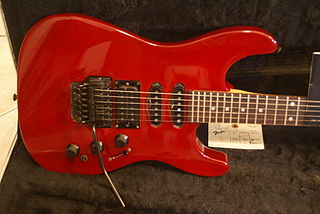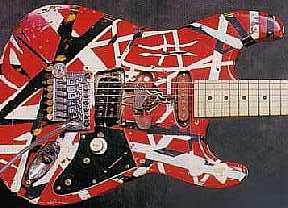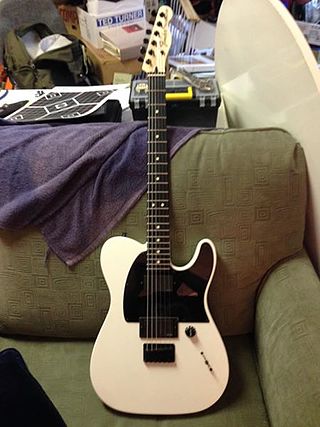Ibanez is a Japanese guitar brand owned by Hoshino Gakki. Based in Nagoya, Aichi, Japan, Hoshino Gakki were one of the first Japanese musical instrument companies to gain a significant foothold in import guitar sales in the United States and Europe, as well as the first brand of guitars to mass-produce the seven-string guitar and eight-string guitar. Ibanez manufactures effects, accessories, amps, and instruments in Japan, China, Indonesia, and the United States. As of 2017 they marketed nearly 165 models of bass guitar, 130 acoustic guitars, and more than 300 electric guitars. After Gibson and Fender, Ibanez is considered the third biggest guitar brand.

The Fender Showmaster is a discontinued model of electric guitar made by Fender, and is characteristic of a superstrat. Also see the badge change of Stagemaster due to legal reasons.

ESP Company, Limited is a Japanese guitar manufacturer, primarily focused on the production of electric guitars and basses. They are based in both Tokyo and Los Angeles, with distinct product lines for each market. ESP Company manufactures instruments under several names, including "ESP Standard", "ESP Custom Shop", "LTD Guitars and Basses", "Navigator", "Edwards Guitars and Basses", and "Grassroots".

Roope Juhani Latvala is a Finnish guitarist, best known as the former rhythm guitarist for the melodic death metal band Children of Bodom from 2003 to 2015 and the co-lead electric guitarist for Sinergy. He was also one of the founding members of Stone, which was one of the first notable bands in the history of Finnish heavy metal.

Superstrat is a name for an electric guitar design that resembles a Fender Stratocaster but with differences that clearly distinguish it from a standard Stratocaster, usually to cater to a different playing style. Differences typically include more pointed, aggressive-looking body and neck shapes with increased cutaways to facilitate access to the higher frets, an increased number of frets on the fingerboard, a contoured heel at the neck joint facilitating easier higher fret access, the usage of humbucking pickups, and locking vibrato systems, most commonly the Floyd Rose.

The Gibson Explorer is a type of electric guitar model by Gibson guitars, released in 1958. The Explorer offered a radical, "futuristic" body design, much like its siblings: the Flying V, which was released the same year, and the Moderne, which was designed in 1957 but not released until 1982. The Explorer was the final development of a prototype design that, years later, Gibson marketed under the name Futura.

Charvel is a brand of electric guitars founded in the 1970s by Wayne Charvel in Azusa, California and originally headquartered in Glendora, California. Since 2002, Charvel has been under the ownership of Fender Musical Instruments Corporation.

A headstock or peghead is part of a guitar or similar stringed instruments such as a lute, mandolin, banjo, ukulele and others of the lute lineage. The main function of a headstock is to house the tuning pegs or other mechanism that holds the strings at the "head" of the instrument; it corresponds to a pegbox in the violin family. At the "tail" of the instrument the strings are usually held by a tailpiece or bridge. Machine heads on the headstock are commonly used to tune the instrument by adjusting the tension of strings and, consequently, the pitch of sound they produce.

Kramer Guitars is an American manufacturer of electric guitars and basses. Kramer produced aluminum-necked electric guitars and basses in the 1970s and wooden-necked guitars catering to hard rock and heavy metal musicians in the 1980s; Kramer is currently a division of Gibson Guitar Corporation.

The EMG 81 is a popular active humbucker guitar pickup manufactured by EMG, Inc. It is usually considered a lead pickup for use in the bridge position, paired with EMG's 85 as a rhythm pickup in neck position. It's not uncommon, however, to see a guitar with two EMG 81s in both bridge and neck positions.

The Frankenstrat, also known as "Frankie", is a guitar created by Eddie Van Halen. Its name is a portmanteau of Frankenstein, the fictional doctor who created a monster by combining body parts of the recently deceased, and the Stratocaster, a model of electric guitar made by Fender.
The Jackson Rhoads is a model of electric guitar, originally commissioned by guitarist Randy Rhoads and produced by Jackson Guitars.
Electric guitar design is a type of industrial design where the looks and efficiency of the shape as well as the acoustical aspects of the guitar are important factors. In the past many guitars have been designed with various odd shapes as well as very practical and convenient solutions to improve the usability of the object.
The Razorback V is an electric guitar designed by Dimebag Darrell shortly before his death in December 2004. It is a more aggressive looking version of the Dean V, and similar to the Dean Razorback. Corey Beaulieu of Trivium is known for using this guitar It is the more pointy version of the Dean Guitar headstock and the body is an enlarged reversed image of the head. There is also a bass guitar version of the Razorback V shape.

The Dean ML is an electric guitar made by Dean Guitars in 1977 along with its counterparts, the Dean V, Dean Cadillac and Dean Z. It has an unusual design, with a V-shaped headstock and V-shaped tailpiece. It was popularized by the guitarist Dimebag Darrell of Pantera.

The Dean Razorback is an electric guitar made by Dean Guitars. It is a variation of the Dean ML, and was designed by Dimebag Darrell, guitarist for the bands Pantera and Damageplan. The Razorback was at first a USA only model, but was subsequently sold as an import model.

The Dean Z Guitar is an electric guitar made by Dean Guitars starting in 1977 along with its counterparts, the Dean ML, Dean V and Dean Cadillac. It has the recognizable Dean headstock and the V-shaped tailpiece. The body shape is similar to the body design of a Gibson Explorer.
The Fender Prodigy is a discontinued model of electric guitar produced by Fender from 1991 to 1993. It is one of Fender's attempts to compete with the superstrat-style guitars produced by Ibanez, Jackson/Charvel, Carvin Corporation and Yamaha. Since the Prodigy series was discontinued after about 2+1⁄2 years of production without a clear reason, it is considered one of Fender's rare models because of its limited production. Fender also produced a Prodigy Bass based on the Precision Bass Plus Deluxe featuring a P/J pickup layout (P as in Fender Precision Bass and J as in Fender Jazz Bass), 2-band active circuitry and a "fine-tuner" Schaller Elite bridge assembly.

The Fender Jim Root Telecaster is a signature model of the Fender Telecaster electric guitar customized for American musician Jim Root. In January 2010, Jim Root's Signature Fender Telecaster was unveiled on the Fender website, similar to the one he has been seen using on stage. As of March 2009, the difference being the headstock. The prototype originally made for Jim came with the 1970s style Stratocaster headstock, which Root had shaved down to a standard Telecaster shape. This made the 1970s Fender Telecaster logo go to the very edge of the headstock. With a mahogany body, a fast neck and active EMG 81/60 pickups, it is a guitar designed for the heavy metal/hard rock guitar player.

















